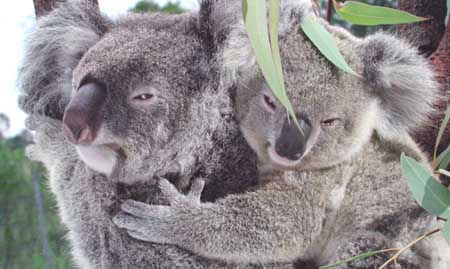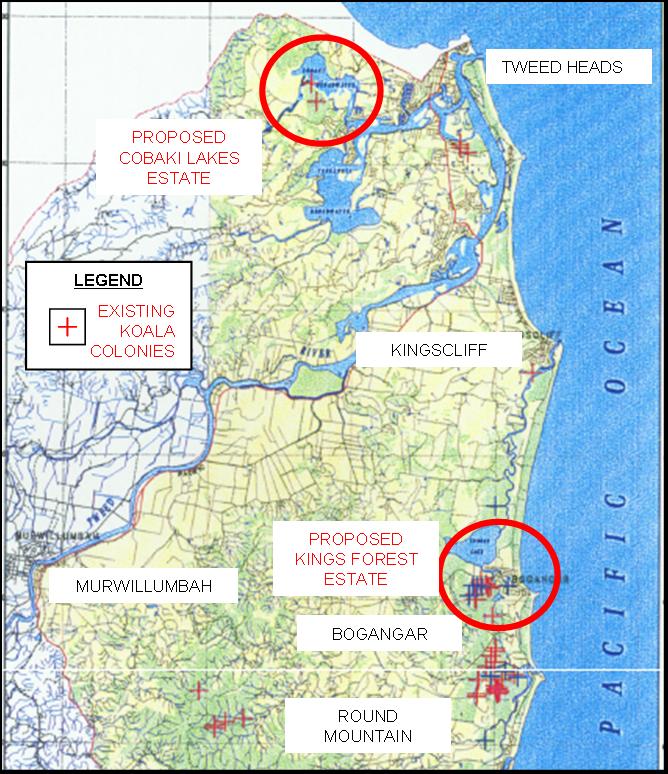Development project threatens second largest Koala Colony in Tweed Shire
The last stand for Tweed Coast koalas - our local heritage and icon at stake!

The Tweed Shire has abundant World Heritage areas and has the highest biodiversity of vertebrates in Australia - more than Kakadu National Park - due to abundant rainfall and rich volcanic soil from Mount Warning.
Kings Forest is a 2,000 + acres (880 hectares) parcel of land that contains critical habitat for the second largest colony of koalas on the Tweed Koala Coast (i.e. 145 to 175 koalas) out of a total of 300 koalas (see map). This is a very significant colony. There are a total of 22 endangered species of animals on this land and hundreds of endangered flora (scribbly gum and rare heathland).
There is currently a proposal by Mr Bob Ell, Executive Chairman, Leda Holdings, GPO Box 2522, SYDNEY NSW 200 before State government to develop the following on this land:
- residential development of 4,500 houses (dogs and cats permitted)
- aged care facility and/or retirement living
- educational facilities (pre-school, primary schools, high school)
- village centre
- church
- service station
- golf course and club house
- neighbourhood centre
- regional community facility
- four-lane boulevard
What threatens koalas' survival?
The biggest killers of koalas (in order of impact) are:
- habitat destruction
- cars
- dogs
All three threats would be present on this development, in addition to others. Felled trees would not only cause loss of habitat for koalas but also loss of koalas' food source. Revegetation of these eucalypt species would take at least five to ten years.
Koala-friendly wildlife corridors
Additionally, the plan includes a golf course, a four-lane road and bicycle paths to interface with the wildlife corridor for koalas who move on foot from tree to tree.
There are no koala-proof fences planned around the roads or overpasses/underpasses to prevent koalas from running onto the roads. This would be disastrous for the koalas and would lead to their local extinction.
Already the koala populations on the Tweed are highly fragmented due to lack of interconnecting wildlife corridors. Without a healthy gene pool their species will become weaker and sicker. This is may be the only healthy koala population in NSW. Other populations of koalas die from disease and weak immunity.
Golf courses spray pesticides, herbicides and fungicides that can be carcinogenic, neurotoxic, and mutagenic, affecting immunity and reproduction of koalas who could inhale and also tread in these toxins. Also fertilisers will kill native species of flora.
World koala experts say that when you reduce habitat and food sources to koalas, their numbers will reduce, so if this goes, all koalas go.
Since pockets of koala habitat occur throughout this area, removing pockets will have a major impact on the colony. Although 50% of the koala population are female, none of them have any sign of breeding due to the stress of logging in the area.
Koala distribution map for the tweed shire (crosses):-
www.tweed.nsw.gov.au/stpuweb/koala.htm
Unsafe human habitat
Due to the high fire-risk nature of the area with so many native trees, this development is very risky for human habitation. Every house would need trees cleared around it, trees that are habitat and a food source for the koalas thus significantly impacting endangered species. This would breach the Environmental Protection and Biodiversity Conservation Act of 1999 (EPBC Act). Furthermore, this is low-lying land prone to floods and close to the coast in the event of rising sea levels.
In summary, this proposal is an ecological disaster for the Tweed Shire.
Koalas extinct by 2020?
There are estimated to be less than 100,000 koalas remaining in Australia, considerably less due to the recent disastrous Victorian bush fires and Queensland floods.
It is incumbent on us to protect those koalas and endangered species remaining not only for our growing tourism industry but for future generations. Currently, Koalas are predicted to become extinct in the wild by 2020.
Considering we are in the Sixth Mass Extinction of all species, it is imperative that we understand that human survival depends on biodiversity.
See also: "Kings Forest Development threatens 21 Threatened Species of Fauna" on Blue Cray of 28 Feb 09.
How you can help
Please write to:
The Director
Coastal Assessments
Department of Planning
GPO Box 39
Sydney NSW 2001
(02)92-285-811
[email protected]
The General Manager
cc The Councillors
PO Box 816
Muwillumbah NSW 2484
email [email protected]
(02)66-702-400.
Deadline: March 2, 2009 (post-dated on envelope)
"Think Globally, Act Locally"


Recent comments